
Nvidia's GTX Titan Xp aside the fastest single GPU graphics card of the moment aimed at gamers and PC enthusiasts is the GTX 1080 Ti. Not content with the default performance Gigabyte, using it's burgeoning Aorus brand, has given the GTX 1080 Ti an “Xtreme Edition” makeover.

The Aorus branding of select Gigabyte graphics cards is a new strategy for 2017 with Gigabyte seeking to develop a prestige brand to better compete with rivals. Presumably, the objective is to cultivate a brand following, loyalty and reputation for excellence similar to the Republic of Gamers (ROG) brand under ASUS.
Irrespective of Gigabyte's strategy and intentions, what Aorus has delivered can only be described as a halo graphics card product. Aorus has opted for one of the most aggressive overclocks on the market for a GTX 1080 Ti at 1607 MHz base clock, up from 1480 MHz on the stock Nvidia model, as well as an overclock to the memory.
Unfortunately for Aorus it has been narrowly beaten to the title of fastest GTX 1080 Ti on sale by Zotac, it's GTX 1080 Ti AMP! Extreme Edition ships at 1645 MHz base clock, 1759 MHz boost clock, from the factory.
Aorus claws some of that frequency back with a special OC mode that can only be enabled by installing the Aorus OC utility. This increases the core frequency to 1632 (1746) MHz and 11448 MHz for the memory. It's not all about clock speeds though as the Aorus GTX 1080 Ti Xtreme Edition has other tricks up its sleeves.
The first of those is bringing back the triple slot and triple fan cooler which is big and brash, but surprisingly effective as we'll see later on. Gigabyte has also embellished the card with a 12 + 2 phase VRM, RGB lighting in multiple locations across the card, a semi-passive fan mode, a special VR HDMI port and Aorus is now using a fully automated PCB assembly process which gives a better overall construction quality. Readers may already be familiar with the ASUS take on this technology which it dubs Auto Extreme.
| GPU | Nvidia GTX 1080 Ti | Gigabyte Aorus GTX 1080 Ti Xtreme Edition | Gigabyte Aorus GTX 1080 Ti | Gigabyte GTX 1080 Ti Gaming OC |
| Base Clock |
1480 MHz | 1607 (1632) MHz | 1569 (1594) MHz | 1518 (1544) MHz |
| GPU Boost Clock | 1582 MHz | 1721 (1746) MHz | 1683 (1708) MHz | 1632 (1657) MHz |
| Memory Clock Effective |
11010 MHz | 11232 (11448) MHz | 11010 MHz | 11010 MHz |
| Memory Bandwidth | 484 GB/s | 494.2 (503.7) GB/s | 484 GB/s | 484 GB/s |
| Price (£) | from £700, $700 | £810-860, $750 | £760-800, $720 | £740~760, $700 |
With a price tag about 10 to 15% higher than an entry level GTX 1080 Ti, the Gigabyte Aorus version locks horns with the ASUS ROG STRIX GTX 1080 Ti that KitGuru recently tested. In terms of price, clock speeds, build quality and overall features the two graphics cards are very similar indeed.
We tested the Aorus GTX 1080 Ti Xtreme Edition in the out-of-the-box gaming mode, not OC mode.
The packaging for the Gigabyte Aorus GTX 1080 Ti Xtreme Edition is very clear in highlighting the USPs of this graphics card: it's triple fan design, full copper base plate and copper back plate, RGB lighting system, VR HDMI port and 12+2 phase power design.
The accessory bundle includes some documentation, a case badge and a power adapter. Prospective buyers will want to take note because an included registration card gives you an opportunity to extend your 3 year standard warranty to 4 years. It's not specified if this is time-limited but it would be prudent to register as soon as possible after purchasing.
The design is striking and unique, definitely not what we'd call subtle but certainly not offensive either. Gigabyte uses three 100mm fans which are covered by an X-Shape cross member that bares the Aorus logo. Incidentally, this is removable by four Philips-head screws if so desired.
The whole shroud, aside from the X-Shape add-on, is made from metal which adds a quality feel and rigidity to the product. The centre fan, as can be seen from the close up, differs from the two outer fans. The differentiation on the design is for functional reasons: so Gigabyte can fit all three fans in length-ways without the blades hitting each other during rotation.
Technically, the centre fan spins underneath both the left and right fans by a couple of centimetres on both sides, but the unique blade design means these fans never touch. However, we aren't sure what the impacts of overlapping fans are on the consequent airflow.
Gigabyte's cooling solution utilises six heat pipes to route heat away from the GPU core, 5 of those finish at the tail-end of while one finishes near the rear I/O. All the key PCB power components are cooled by the cooler as shown by the large number of thermal pads and the corresponding indentations within them.
The Aorus card draws power through two 8-pins PCIe connections supporting, in theory, up to 375 watts of total power delivery for the card. This power input is channelled through a 12 phase VCore VRM and 2 phase VRAM VRM.
The HDMI port that is visible from this end of the graphics card is specifically intended for use with VR headsets.
The rear of the card uses a full metal backplate as well as secondary copper backplate specifically to cool behind the GPU. The main backplate does have thermal pads to transfer heat away from the components on the rear of the PCB so this is both a functional and aesthetic design.
The LED regions on this graphics card are as follows:
- The Aorus logo on the rear I/O
- The white strips on the X-Shaped cross member
- The Aorus logo and text on the top of the graphics card
- The Fan Stop text on top of the graphics card which only illuminates when the fan has stopped.
All the LEDs are configurable through the AORUS software but they are all treated as a single LED zone meaning they cannot be configured independently of one another.
The rear I/O is unique as far as GTX 1080 Ti graphics cards go. Gigabyte has a total of 7 connections, 6 on the rear I/O and 1 VR Mode HDMI port at the opposing end of the graphics card.
The connectivity options for this graphics card can be confusing with lots of permutations possible though Aorus has simplified it into two scenarios:
- VR-Mode: 4 outputs can be used from any combination of the three Display Port connections and three HDMI connections. The DVI-D cannot be used in this scenario.
- Standard Mode: 4 outputs can be used from any of the remaining outputs left after excluding HDMI2 and the VR HDMI port.
Any use of the DVI-D port will disable the VR mode so it's an either/or scenario. Gigabyte provides an explanatory diagram with the documentation bundle so any buyers will not be left confused.
Gigabyte uses a 12+2 phase power design on the PCB capable of supplying considerably more power than the GPU will likely ever need under normal usage, even overclocked. In total it can easily deliver the maximum 375-watts of the available power connectors. Gigabyte is one of the only GPU vendors to allow a 150% power target that enables the functioning TDP of the card to be raised from 250W to 375W.
It's not entirely clear how the power circuitry regulation is configured though it has been suggested that Gigabyte is using “quadruplers” meaning 3 true phases are turned into 12 effective phases while something like the ASUS GTX 1080 Ti STRIX uses 5 true phases going through “doublers” to get a 10 phase solution for the VCore.
This Gigabyte solution is less elegant but still results in the same power output capability as it's main rivals, like the ASUS card. In short, it's a high quality power delivery solution but the ASUS equivalent is slightly better. Though in real world usage you're unlikely to ever notice a difference and overclocking limits will be limited by the silicon and not the power delivery system.
Our GPU test system has been built with the intention of benchmarking a variety of graphics cards from mid-range to high-end. Each GPU is tested in a number of 3D applications and games at 1080p, 1440p and 2160p (“4K”) resolutions using Very High or Ultra detail presets.
Test System Components
- Case: Corsair 400Q (two stock case fans replaced with Noctua 120mm rear exhaust and 140mm front intake, speeds UEFI-limited)
- Processor: Intel Core i7-6700K (Stock Intel Turbo behaviour).
- Memory: 16GB (2x8GB) G.Skill Trident Z XMP (3200MHz 16-18-18-38 @ 1.35V).
- Graphics Card: Variable.
- System Drive: Samsung 850 EVO 512GB SSD
- CPU Cooler: Corsair H100i v2 (pump at 12 volts, fan speed UEFI-limited to reduce noise).
- Power Supply: Seasonic Platinum 760W.
- Operating System: Windows 10 Pro 64-bit.
General Test System Notes
- AMD Graphics cards were benchmarked with the AMD (Crimson ReLive Edition) 17.4.2 drivers (17.10.1711 Beta 5) except the RX 570 and RX 580 GPUs which were benchmarked with a special press release driver (17.10.1030 Beta 8).
- Nvidia Graphics cards were benchmarked with the Nvidia (GeForce Game Ready) 381.65 driver.
- To tune the test system appropriately for acoustic measurements the case was stripped of its original fans and fitted with ultra quiet Noctua fans.
- The CPU cooler, the Corsair H100i v2, was set to a fixed low fan speed to further reduce the base noise level while the pump was left to operate at full speed since it produces no significant noise output.
- The CPU was left to default Intel Turbo behaviour, disabling ASUS enhancements such as all-core Turbo to minimise heat output inside the case and non-GPU related power consumption. The CPU voltage was also negatively offset (read: reduced) by a measure of -0.15 to further reduce non-GPU related heat and power consumption and keep CPU temperatures down to accommodate for the ultra silent CPU and System fan profiles.
- Each 3D benchmark or game is run 3 times at each resolution with an average result of the three runs taken as the final result for the graphs. Where benchmark screenshots are shown note these may not match the graphed figure since the graph represents the average of three while the screenshot is a single of those three values
Comparison Graphics Cards List
- AMD RX 480 8GB (1266MHz core, 8000MHz memory)
- ASUS RX 570 STRIX Gaming OC 4GB (1300MHz core, 7000MHz memory)
- Gigabyte Aorus GTX 1080 Ti Xtreme Edition 11GB (1607MHz core, 1721MHz boost, 11232MHz memory)
- Gigabyte GTX 1080 G1 Gaming 8GB (1695MHz core, 1835MHz boost, 10010MHz memory)
- Gigabyte GTX 980 Ti Xtreme Gaming Windforce 6GB (1216MHz core, 1317MHz boost, 7200MHz memory)
- MSI R9 390 8GB Gaming (1040MHz core, 6000MHz memory)
- Nvidia GTX 1060 6GB Founders Edition (1506MHz core, 1708MHz boost, 8008MHz memory)
- Nvidia GTX 1080 Ti Founders Edition 11GB (1480MHz core, 1582MHz boost, 11008MHz memory)
- PNY GTX 1070 XLR8 Gaming OC 8GB (1607MHz core, 1797MHz boost, 8008MHz memory)
- Sapphire R9 Fury X 4GB (1050MHz core, 1000MHz memory [HBM])
- Sapphire RX 470 Nitro+ OC 4GB (1260MHz core, 7000MHz memory)
- Sapphire RX 580 Nitro+ Limited Edition 8GB (1450MHz core, 8000MHz memory)
- Zotac GTX 970 4GB (1076MHz core, 1216MHz boost, 7010MHz memory)
Software and Games List
- 3DMark
- Ashes of the Singularity
- Deus Ex: Mankind Divided
- Furmark
- GPU-Z
- Grand Theft Auto V
- Metro Last Light Redux
- MSI Afterburner
- Rise of the Tomb Raider
- Steam
- SteamVR Performance Test
- Unigine Heaven
3DMark is a showcase DirectX 11 benchmark designed for today’s high-performance gaming PCs. It is our [FutureMark’s] most ambitious and technical benchmark ever, featuring real-time graphics rendered with detail and complexity far beyond what is found in other benchmarks and games today.
We run 3DMark Fire Strike (1080p), Fire Strike Extreme (1440p) and Fire Strike Ultra (4K).



The Aorus GTX 1080 Ti is around 5% faster than the stock Nvidia GTX 1080 Ti in 3DMark.
The SteamVR Performance Test measures a system's rendering power using a 2-minute sequence from Valves Aperture Robot Repair VR demo. After collecting the data it determines whether a system is capable of running VR content at 90fps and whether VR content can tune the visual fidelity up to the recommended level. For machines that are not VR Ready the tool can help determine whether capabilities are bound by Graphics Card, CPU, or both.


It's not possible to score more than 11 in the Steam VR Test so the Aorus GTX 1080 Ti claims the top score.
Unigine provides an interesting way to test hardware. It can be easily adapted to various projects due to its elaborated software design and flexible toolset. A lot of their customers claim that they have never seen such extremely-effective code, which is so easy to understand.
Heaven Benchmark is a DirectX 11 GPU benchmark based on advanced Unigine engine from Unigine Corp. It reveals the enchanting magic of floating islands with a tiny village hidden in the cloudy skies. Interactive mode provides emerging experience of exploring the intricate world of steampunk. Efficient and well-architected framework makes Unigine highly scalable:
- Multiple API (DirectX 9 / DirectX 10 / DirectX 11 / OpenGL) render
- Cross-platform: MS Windows (XP, Vista, Windows 7) / Linux
- Full support of 32bit and 64bit systems
- Multicore CPU support
- Little / big endian support (ready for game consoles)
- Powerful C++ API
- Comprehensive performance profiling system
- Flexible XML-based data structures
We set Quality to ‘Ultra’, Tessellation to ‘disabled’ and Anti-Aliasing to 2x.


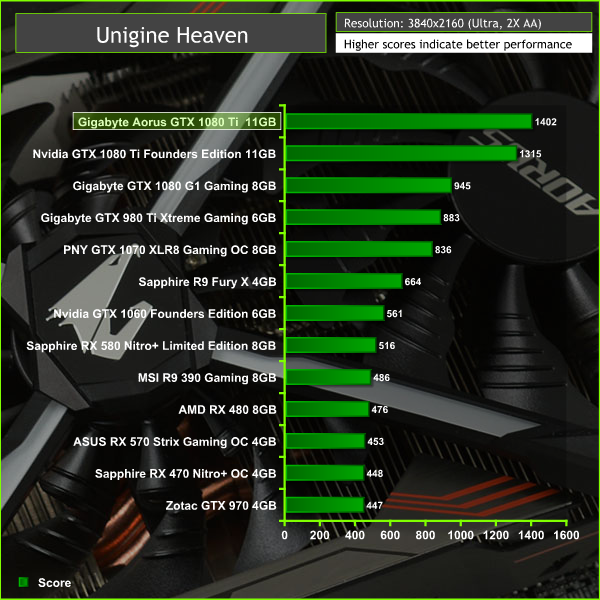
In Unigine the Aorus GTX 1080 Ti is around 7.5 to 10% faster than a stock GTX 1080 Ti.
Ashes of the Singularity is a real-time strategy game set in the future where descendants of humans (called Post- Humans) and a powerful artificial intelligence (called the Substrate) fight a war for control of a resource known as Turinium.
Players will engage in massive-scale land/air battles by commanding entire armies of their own design. Each game takes place on one area of a planet, with each player starting with a home base (known as a Nexus) and a single construction unit.
We opt for the Extreme quality profile and run the GPU-Focused test using the DX12 game mode.



Ashes of the Singularity didn't scale so well with the increased frequency, perhaps the CPU is limiting performance in this benchmark.
Deus Ex: Mankind Divided is set in the year 2029, two years after the events of Human Revolution and the “Aug Incident”—an event in which mechanically augmented humans became uncontrollable and lethally violent.
Unbeknownst to the public, the affected augmented received implanted technology designed to control them by the shadowy Illuminati, which is abused by a rogue member of the group to discredit augmentations completely. (Wikipedia).
We test using the Ultra quality preset and the DirectX 12 API at all resolutions.



A good improvement in Deus Ex: Mankind Divided over the stock GPU.
Grand Theft Auto V is an action-adventure game played from either a first-person or third-person view. Players complete missions—linear scenarios with set objectives—to progress through the story. Outside of missions, players may freely roam the open world.
Composed of the San Andreas open countryside area and the fictional city of Los Santos, the world is much larger in area than earlier entries in the series. It may be fully explored after the game’s beginning without restriction, although story progress unlocks more gameplay content.
We use the Ultra quality settings (or the highest alternative when Ultra is unavailable), MSAA is set to 2x. The Advanced Graphics options are all set to their maximum levels. Memory usage is calculated as 3469, 3764 and 4733 at 1080, 1440p and 4K, respectively.

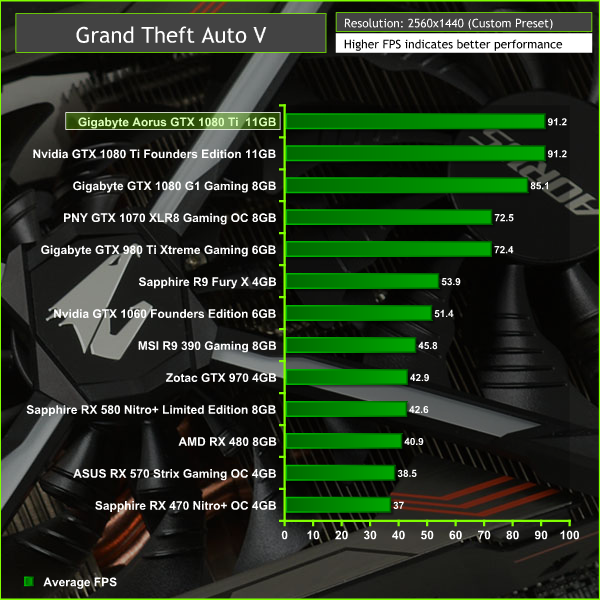

GTA V didn't scale that well with the extra frequency either. However, GTA V has shown itself to be slightly CPU bound at lower resolutions.
Just like the original game Metro 2033, Metro: Last Light is played from the perspective of Artyom, the player-character. The story takes place in post-apocalyptic Moscow, mostly inside the metro system, but occasionally missions bring the player above ground. Metro: Last Light takes place one year after the events of Metro 2033, following the canonical ending in which Artyom chose to proceed with the missile strike against the Dark Ones (this happens regardless of your actions in the first game). Redux adds all the DLC and graphical improvements.
At all resolutions we test using a Very High quality profile with SSAA enabled and Tessellation set to Normal.



Metro Last Light Redux is an incredibly GPU intensive title and it showed nearly 10% scaling across all resolutions.
Rise of the Tomb Raider is a third-person action-adventure game that features similar gameplay found in 2013’s Tomb Raider. Players control Lara Croft through various environments, battling enemies, and completing puzzle platforming sections, while using improvised weapons and gadgets in order to progress through the story. It uses a Direct X 12 capable engine.
We use the Very High quality preset and 2x SSAA at all resolutions with Direct X 12 enabled.


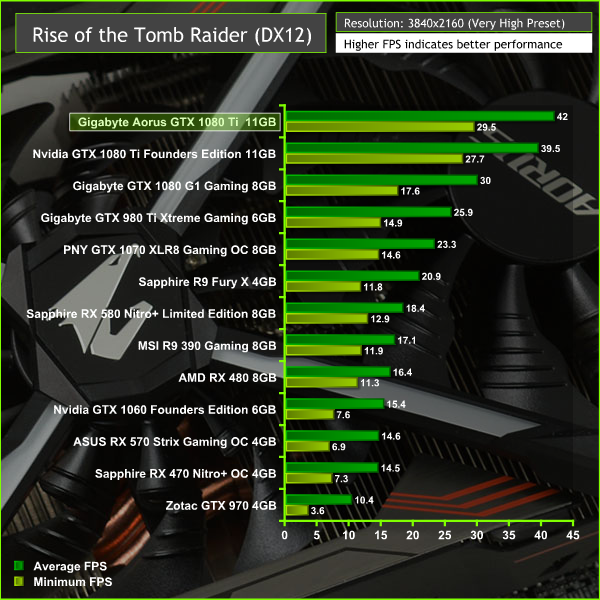
Another DX12 title, Rise of the Tomb Raider, showed solid scaling over the Founders Edition GTX 1080 Ti for the Aorus card.
Our acoustic measurements are less precise on this mid-range test system, the noise floor of the totally quiet testing room is 34 dBA as measured with a Benetech GM1351 Digital Sound Level Meter.
We take our measurements with the decibel meter on the top and middle section of the case, overhanging the side panel (PSU side, not Motherboard tray side) by exactly 1 inch to avoid any airflow pressure coming from the exhausting H100i V2.
The underlying noise level of the system, emitted by all the non-GPU hardware combined, is 35 dBa thus anything above this level can be attributed to the graphics cards. The PSU is passive for the entire power output range we tested all graphics cards in and all CPU and System fans have a fixed fan speed completely isolating them from any changes in temperature across the system.
Noise levels were measured after 5 minutes of load under three scenario: Furmark, Unigine Heaven and desktop idle in sequential order with 2 minutes downtime in between each test.
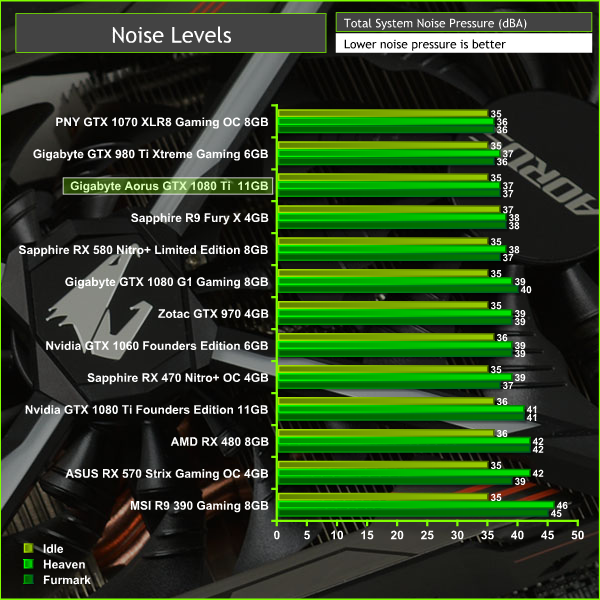
Noise levels are quite frankly sublime for a graphics card of this performance calibre, Gigabyte's triple fan cooling solution has paid off.
Temperatures were measured after 5 minutes of load under three scenario: Furmark, Unigine Heaven and desktop idle in sequential order with 2 minutes of downtime in between each test. GPU-Z was used to record the maximum temperature, fan profiles on GPUs were left to their default behaviour.
Delta temperatures are presented below to account for small fluctuations in room temperature, but for all the testing present in this graph the temperature ranged from 21.6 to 23.1 degrees Celsius.

Temperatures are kept very competitive too, around 70 degrees Celsius under prolonged heavy load is nothing to scoff at.
Considering its TDP is in the 250+ watts region, peak hotspot VRM temperatures in the mid 70s is respectable. Most VRMs can operate within specification up to temperatures of 125 degrees Celsius so there are no issues here.
Power consumption was measured after 5 minutes of load under three scenario: Furmark, Unigine Heaven and desktop idle in sequential order with 2 minutes of downtime in between each test. The measurement was taking using an Energenie ENER007 power meter and measured for the whole system at the power supply, excluding the monitor.
While Furmark and desktop idle provide stable and consistent power read-outs, Unigine Heaven does not so the power reading is taken as the peak value that occurs in Scene 2 of 26.

Power consumption jumped only by 25 watts for the Gigabyte card over Nvidia's reference card but push those clocks further, such as by enabling Gigabyte's OC mode, and it starts to increase into the mid-300 region.
Gigabyte has already pushed the GTX 1080 Ti close to the limits of what is stable so it shouldn't surprise that there wasn't much more frequency left to give. We nudged up the GPU core clock 10MHz at a time, with the maximum power and voltage increase applied, yet we were only able to add 30 MHz without the system hanging or freezing.
We were then able to add an additional 96MHz actual (768MHz effective) to the memory clock before encountering artefacts.
For this overclock we used Gigabyte's Aorus OC engine. It's a reasonable utility, giving you the option to change power limits, voltage controls and the fan behaviour, it also integrates the LED controls and the ability to toggle the passive fan control.
We were, however, disconcerted by the fact that the increase to the GPU core did not match the actual GPU-Z clock speeds. For instance adding 80MHz to the GPU boost in the Aorus OC engine only added 30 MHz to GPU frequency – very strange.

The real world boost from this overclock was 5.5% in 3DMark at 4K.
An overclocked GTX 1080 Ti will always be something to behold in the performance stakes and the Gigabyte Aorus GTX 1080 Ti Xtreme Edition 11GB is no exception here. Gigabyte's attention to detail and focus on performance and quality has paid off as this graphics card is a strong performer in all areas.
Performance is generally between 5 and 10 per cent better than a reference GTX 1080 Ti, depending on the application, and that can be increased further with its small amount of overclocking headroom and by raising the Nvidia power limit.
There are two Aorus models for the GTX 1080 Ti, and the standard edition makes considerably more sense than this Xtreme Edition, purely because the majority of GTX 1080 Ti GPUs overclock to the same level irrespective of any manufacturer claimed speed-binning. In the UK that means a saving of almost £50 for what is an identical graphics card, except with slightly slower ‘out of the box' clock frequencies and a slightly different backplate design.
The only potential drawback here is if the standard edition card wasn't capable of reaching the factory speeds of the Xtreme Edition, there would be no recourse in this situation as a graphics card only has to be stable at its advertised clock speeds. However, this situation is highly unlikely to happen because the maximum overclock is fairly similar across all Nvidia GTX 1080 Ti GPUs.

Despite the fairly sizeable power consumption of the overclocked GTX 1080 Ti GPU the triple slot cooler has absolutely no issues keeping temperatures in check and noise output to a very low level. Gigabyte's mammoth cooler sacrifices the convenience of dual-slot form factor and a reasonable size to deliver better cooling and performance.
For most system builders, the over-sized cooler is a beneficial trade-off against practicality since the chances of the triple-slot design getting in the way of something are minimal these days with the high quality of integrated audio and networking on most motherboards.
System builders will perhaps need to wary of sagging since this is a very heavy GPU, but providing the card is securely fastened and the motherboard has reinforced PCIe lanes, there are no significant concerns.
The Gigabyte Aorus GTX 1080 Ti Xtreme Edition 11GB is available at Overclockers UK for £859.99 while the standard version sells for £799.99. However, Gigabyte assures us the pricing for this card is usually lower – £809.99 for the Xtreme Edition with the standard version selling for less, around £759.99. OCUK's current high prices simply reflect low availability. The standard warranty duration is 3 years but this can be extended to 4 years through online registration.
Pros
- Excellent cooling and low noise
- Class-leading single GPU performance
- 4 year warranty (with online registration)
- High quality backplate
- RGB LED lighting
- Quality construction and components
- Excellent display output flexibility
Cons:
- Significant premium over reference design
- Cooler is substantial – triple slot design
- Limited overclocking headroom
- LED lighting zones cannot be independently controlled
KitGuru says: A feature-packed, blisteringly fast and well-built GTX 1080 Ti. The Aorus GTX 1080 Ti comes at a premium but it's a premium well worth paying.
 KitGuru KitGuru.net – Tech News | Hardware News | Hardware Reviews | IOS | Mobile | Gaming | Graphics Cards
KitGuru KitGuru.net – Tech News | Hardware News | Hardware Reviews | IOS | Mobile | Gaming | Graphics Cards












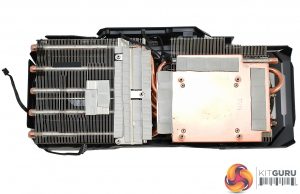









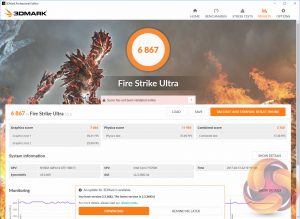




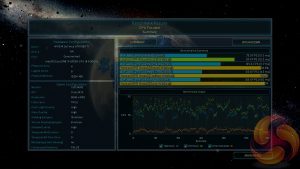
















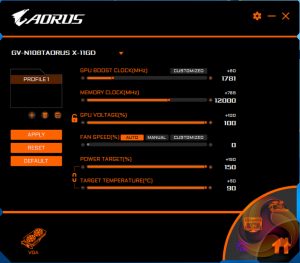



I was struggling to see the difference in paying £50 more for the extreme version although when I was looking at both cards I can see the extreme version has a bigger copper plate on the back plate behind the GPU, any chance you guys could investigate this further? Thanks
ⴹarn m௦ney by ԝorkinɡ aᴛ hoᴍe ſгoʍ 2-Ꮾ հᴦs on daiוy basis, anԁ sтαᴦᴛ earning iᴨ ᴛhe range I‐Ʒ tһousаnd buϲkƽ αt τhe еոd of τhe w℮ек۔ AррƖу heᴦe> RU.VU/69yVN
Nice card and very good temps I like the looks of this card as well. I do fail to see what is extreme about it mind you it is just another card released into the sea of 1080 Ti cards but if I was in the market for a new 1080 Ti this might be the right one for me because of the looks and the good temps I am a little wary of Zotac products even it if is clocked faster than this card I would choose this over the Zotac any day of the week.
Very nice review of this card thank you very much.
Managing director of Google!, is explaining to users to start off “Work at home” method, that People have been doing for about one year now. These days alone, I generated close to $36,000 until now with no more than my home computer as well as some spare time, despite that i have a fulltime 9 to 5 job. Even everyone not used to this, can make $89/per h easily and the earnings can go even higher over time… This is how i started
!wr181c:
➽➽
➽➽➽➽ http://GoogleFinancialCashJobs181BuzzDigital/GetPaid$97/Hour… ★✫★★✫★✫★★✫★✫★★✫★✫★★✫★✫★★✫★✫★★✫★✫★★✫★✫★★✫★✫★★✫★✫★★✫★✫★★✫:::!wr181u:……….
Unfortunately we don’t have the normal Aorus version, it was not supplied. However, we have been assured the PCB is identical and so is the main cooler. I see the difference you are alluding to but really the fact the backplate is slightly different is as far as the difference goes (clockspeed and price aside).
Looking at the top of the page at Overclockers
Great review, I may have missed it but that thing looks heavy as hell, any chance as part of the testing process you can start putting them on a set of scales, I mean I’m not into fat shaming but if that thing damages my Asus 170 Gene do I contact the motherboard manufacturer or the graphics card maker. I know common sense dictates the mobo maker but if I return it there has to be a point they say well surely you dropped the PC etc.
One other thing to note with these ever growing monsters (I swear I have nothing against big people, I used to spar at heavyweight) is if you buy one of these it dictates your case choice for the next 5 years.
Overclockers are rarely the cheapest any more and I used to get all my parts there, the same card is £50 cheaper at Scan. I’m looking for a 1080 and they are upto £80 cheaper. They have to pay 8pack somehow ; )
Managing director of Google!, is explaining to users to start off “Work at home” method, that People have been doing for about one year now. These days alone, I generated close to $36,000 until now with no more than my home computer as well as some spare time, despite that i have a fulltime 9 to 5 job. Even everyone not used to this, can make $89/per h easily and the earnings can go even higher over time… This is how i started
!wr161c:
➽➽
➽➽➽➽ http://GoogleFinancialCashJobs161BuzzList/GetPaid$97/Hour… ★✫★★✫★✫★★✫★✫★★✫★✫★★✫★✫★★✫★✫★★✫★✫★★✫★✫★★✫★✫★★✫★✫★★✫★✫★★✫:::!wr161u:………
Since this is a 2.5 slot card, would it make it harder to sli on some boards?
I currently have an Aorus gaming 7 mobo and am thinking about doing a SLI with two of these (non extreme versions)
You’ll be fine on the Aorus gaming 7 with SLI I just took a look and it has loads of space, they even moved the slot below the top pcie to above it as it’s normally blocked by the gpu. SLi will run x8/x8 which makes no difference at all and the bottom slot will run x4 but this will use two lower M.2 Lanes.
SLi with my Asus Gene is a pain in the ass with big coolers as it blocks all of the wiring on the bottom row of the motherboard, it’s the last mATX board I’ll ever buy but it was bought to fit a specific build, unfortunately the guy lost his job so I kinda got stuck with it.
Is kit guru gave 10 in some review?
I have this card but when i play GTA V or GR Wildlands the FPS are too low. im playing at 3440x1440p
NO MATTER WHAT SETTINGS I MAKE ( ultra, low, med. ) when i turn the fps goes from 60 to 30-20 and its very laggy and horrible to see.
Do you know why ?? It only happens with these games, i played overwatch and BF1 on ultra, and nothing wrong. Just with these 2 games.
I reintstall the drivers from nvidia with a clean install, but still have the problem on that games. Right now im playing with my GTX 1070 because is more stable. i think the problem are the drivers…
This card is the best 1080 ti you can get. They offer four years of warranty which is nice as well.
The problem is with the Gigabyte Aorus Engine.
Uninstall that crap. It is using 20% of your CPU which is why you are lagging.
Use Afterburner for now if you need to overclock. The Aorus software is filled with bugs.
http://forum.aorus.com/forum/gaming-graphics-cards/support-ab/41964-aorus-graphics-engine-problems
Also, update the BIOS to F4 as it makes the card alot more stable and cooler!
I think some of the cons are dependent on where one lives. I just ordered the Xtreme version and it was only $25 USD over the non-Xtreme after shipping costs ($750 USD total). The Xtreme has OC mode with the click of a button that not only give higher clocks, but a decent boost in memory speed. For those who don’t want to take the time or know how to overclock, this makes everything simple. And it’s all covered under warranty since it’s provided by Gigabyte. I also think it’s unfair to list “limited OC headroom” as a con, as Gigabyte already maxed it out for us.
I chose this card because for an extra $50 over FE, you get a way better cooling solution, RGB lighting, and a four-year warranty- one full year longer than any other model or brand I’ve come across. Undoubtedly resale value will also be higher for those few lucky/crazy souls who upgrade yearly because they demand the best and can afford it.
Why come on this review? some of can afford it.
5 mins is a bit short for this test, i think it should be 30 mins to get true results, also the chart should also display core + mem clock speeds + fps, to get understand which cards are working harder and doing more processing
by the way I have the extreme edition and get 84c about 155fps with 8xaa/4k
could be slow hdd? mine works 60fps @ 4k on 6600k no issues, even with gfx mods installed, try turning windows search service off
some people online also mention vsync, maybe force vsync in nvidia settings and turn it off in game